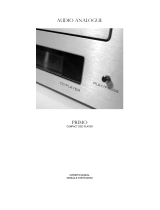
A/B Repeat. Continuous repeat of any part of a CD is accomplished by the A/B funcion.
To select the CD part to be repeated, go to the beginning of the section using the ( and
( keys on the remote control, then press the A/B key once. The “Ae symbol will appear
on the display. Then, reach the final point of the section to be repeated and press the
“A/B” key again. The “B” letter will complete the “AeB” symbol and the repeat will
begin. To defeat the A/B repeat, press the A/B key again or stop the CD.
Shuffle Play. Shuffle play means that the tracks in the CD or in the program are played
in random sequence. To enable the shuffle play press the SHUFFLE button on the
remote control. To defeat the shuffle play press the SHUFFLE button again or stop the
disc by pressing the STOP button.
Selezione della visualizzazione del tempo. Normalmente, il display visualizza il tempo
trascorso dallíinizio della lettura del brano attuale. Se il pulsante TIME viene premuto
una volta, il simbolo “TOTAL” appare alla sinistra del simbolo “TIME” ed il tempo
trascorso dallíinizio del CD o del programma viene visualizzato. Se il pulsante viene
premuto ancora, il simbolo “REM” compare tra “TOTAL” e “TIME” viene visualizzato il
tempo rimasto sull'intero disco. Con una terza pressione, il display normale viene
ripristinato ed i simboli “TOTAL” e “TIME” scompaiono.
Tastierino Numerico. È possibile selezionare direttamente i brani dall’1 al 9 usando il
pulsante corrispondente. Oltre il brano 9, occorre premere i tasti delle cifre che
compongono il numero della traccia entro qualche secondo. Esempio: per scegliere il
brano 15, premere “1” e subito dopo “5”.
Programmazione. Un programma è una lista di brani. Quando viene memorizzato un
programma nel CD player, solo le tracce contenute nel programma possono essere
riprodotte, finchè il programma non viene cancellato premendo il pulsante STOP con
il CD già fermo. Per creare un programma, fermare il CD ed effettuare le seguenti
operazioni:
2 premere il pulsante PROGRAM sul telecomando: a questo punto il simbolo “PROGRAM”
comparirà sul display, il contatore di traccia indicherà il numero di tracce finora selezionate,
mentre il contatore del tempo indicherà il tempo totale di durata del programma;
3 ripetere i passi 1 e 2 fino a che tutte le tracce desiderate saranno inserite nel
programma. Durante la programmazione il simbolo “PROGRAM” lampeggia. Al termine
della programmazione il simbolo ”PROGRAM” cessa di lampeggiare. A questo punto,
Ë possibile premere ancora il pulsante PROGRAM per scorrere la lista delle tracce
selezionate nel programma. Non è necessario che le tracce vengano selezionate nello
stesso ordine con cui compaiono nel CD: per esempio, se si desidera riprodurre prima
la traccia 9 e poi la 5 è sufficiente inserire nel programma la traccia 9 prima della traccia
5. La funzione di scansione delle tracce non è attiva quando è presente un programma.
Scansione automatica del CD. È possible ascoltare i primi secondi di ciascuna traccia
contenuta nel CD premendo il pulsante SCAN sul telecomando. Alla fine della scansione,
o quando viene premuto STOP, il CD si arresta. È possibile anche interrompere la
scansione, continuando quindi la lettura di un certo brano, premendo ancora il pulsante
SCAN.
Ripetizione di una parte qualsiasi del CD. È possibile selezionare una qualunque
porzione di un CD tramite la funzione A/B. Portarsi sul punto iniziale della sezione da
telecomando. Sul display apparirà il simbolo “Ae. Raggiungere il punto finale della
sezione da ripetere e premere ancora il pulsante A/B. Sul display la lettera B completerà
il simbolo “AeB” e inizierà la ripetizione. Per terminare la ripetizione premere ancora
il pulsante A/B o terminare la riproduzione premendo il pulsante STOP.
Riproduzione in sequenza casuale. Shuffle significa che le tracce nel CD vengono
lette in ordine casuale. Per attivare questa funzione, premere il pulsante SHUFFLE sul
telecomando. Per terminare la risproduzione in ordine casuale, premere ancora il
pulsante SHUFFLE o terminate la lettura del CD premendo il pulsante STOP.
Even though the standby facility is designed to alIow the player to be left powered-up
continuously and therefore already "warmed up" and ready to give its best, we advice
you to disconnect the player from mains if unattended for a Iong time. This is to avoid
the risk of damage arising from mains survoItages (Iightning).
Benché la funzione di standby serva a lasciare il lettore continuamente acceso e quindi
sempre "caldo" e pronto a dare il meglio, consigliamo di sconnetterlo dall'alimentazione
di rete in caso di un periodo prolungato di inutilizzo. Questo serve a ridurre il rischio
di danni derivanti da sbalzi di tensione (fulmini, etc.) sull'alimentazione di rete.
13
FUNZIONI
SPECIFICHE DEL
TELECOMANDO
NOTES ON THE USE
OF THE STANDBY
FUNCTION
PARTICOLARITÀ
SULL’USO DELLA
FUNZIONE STANDBY






















